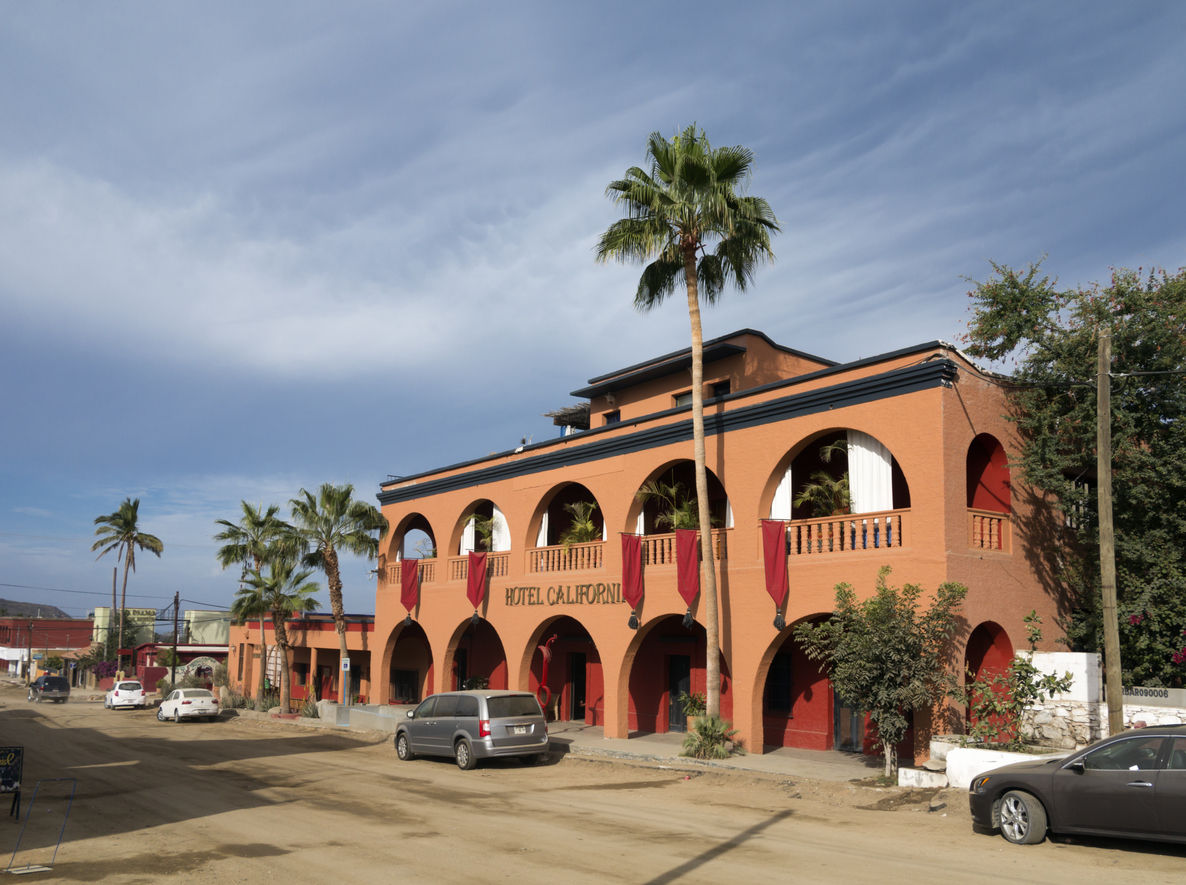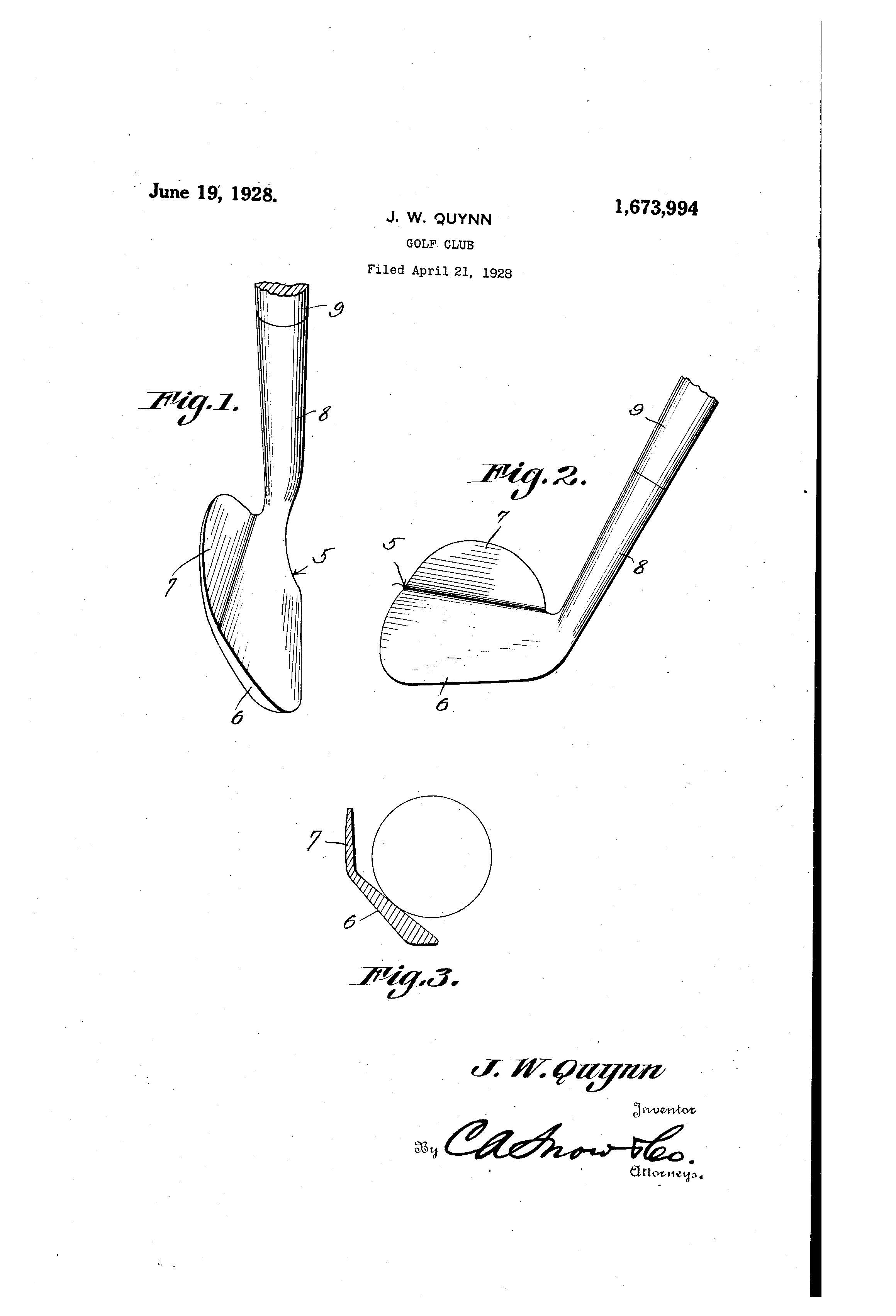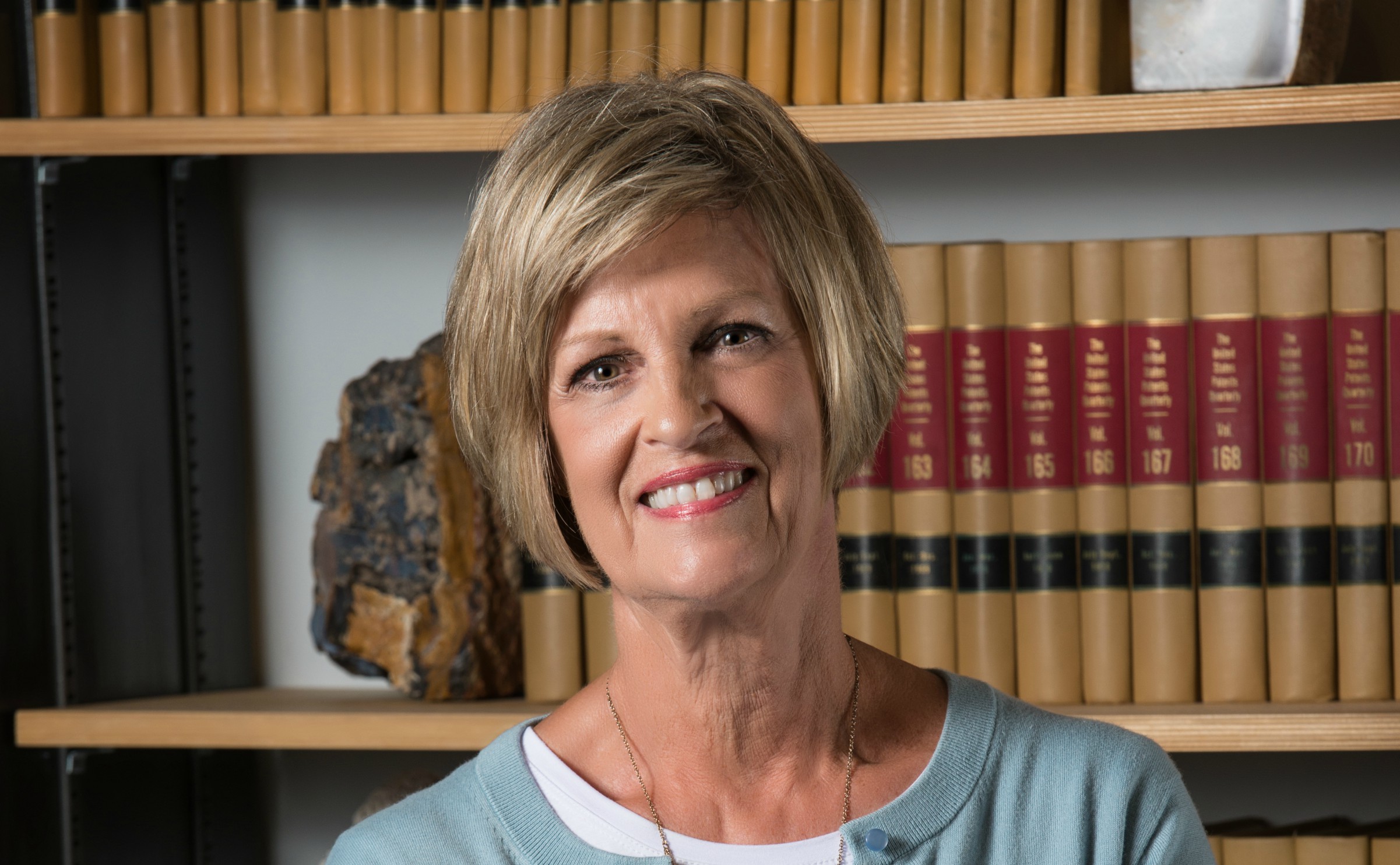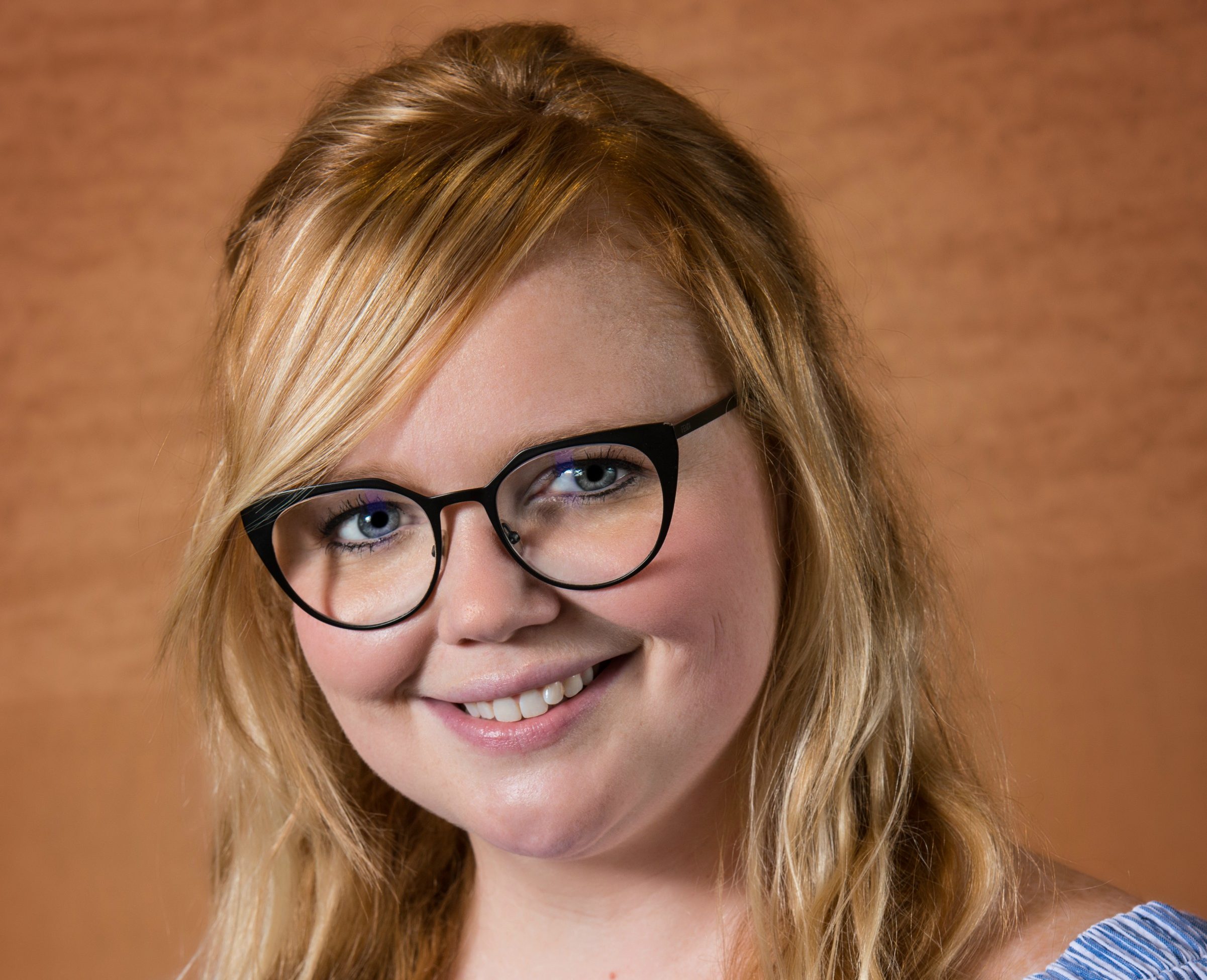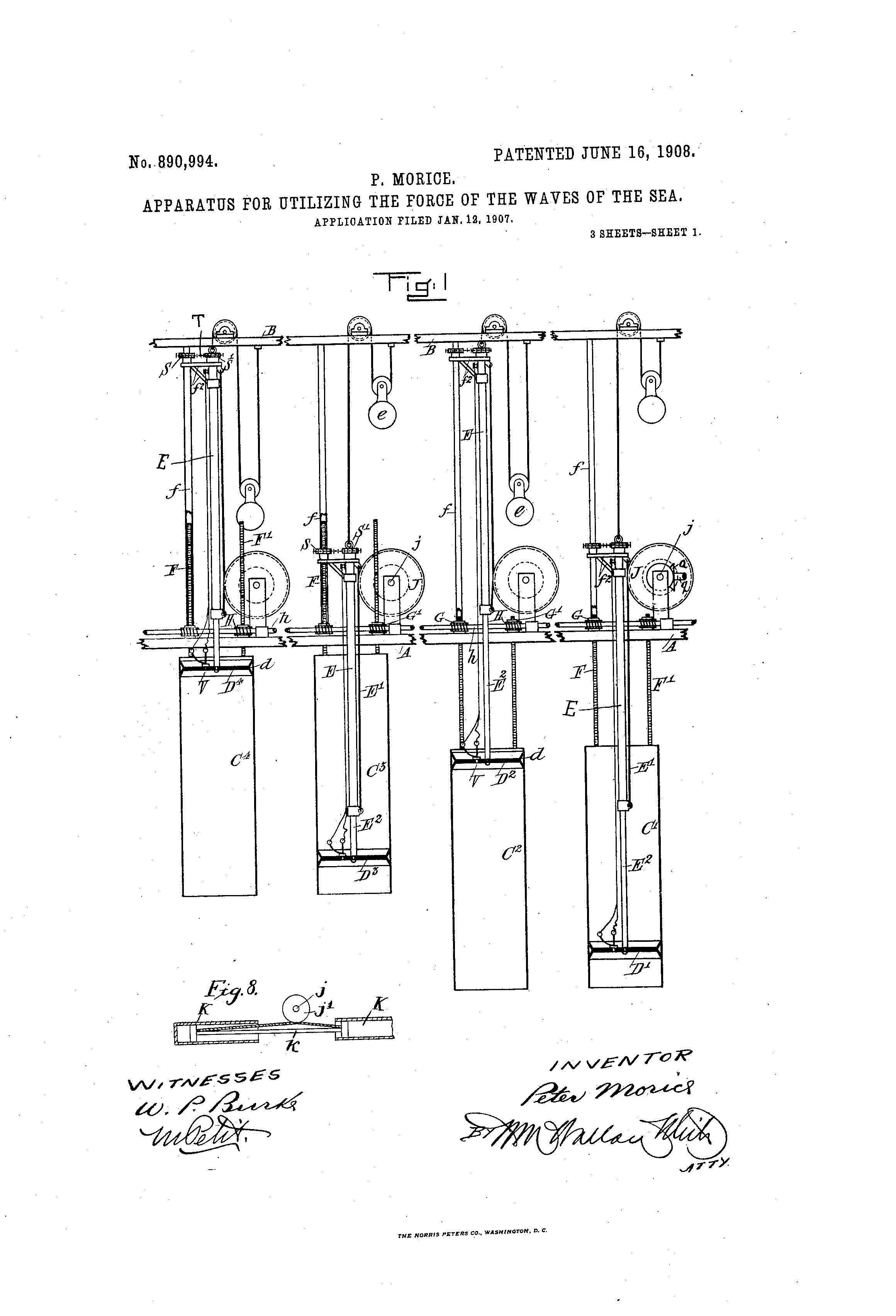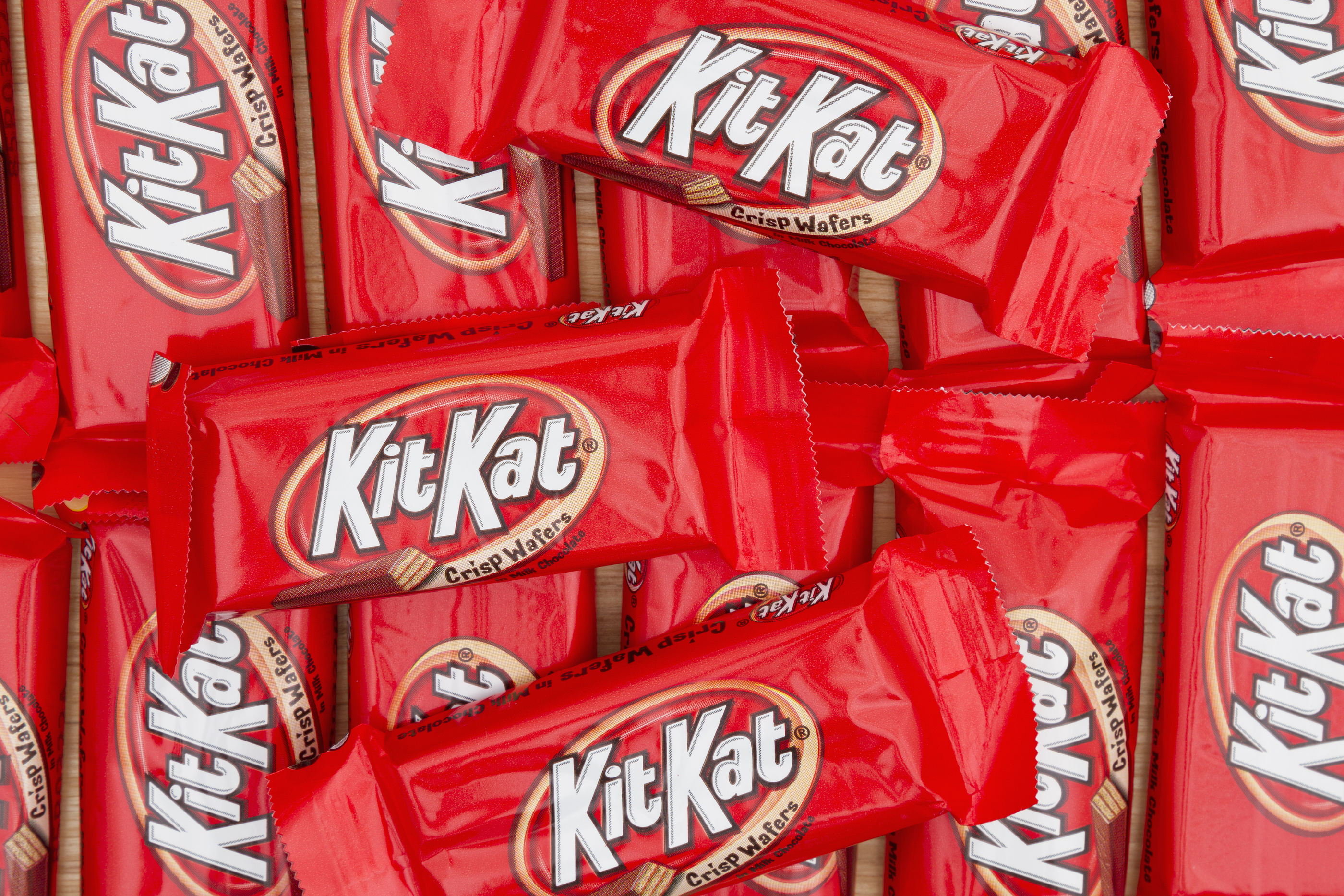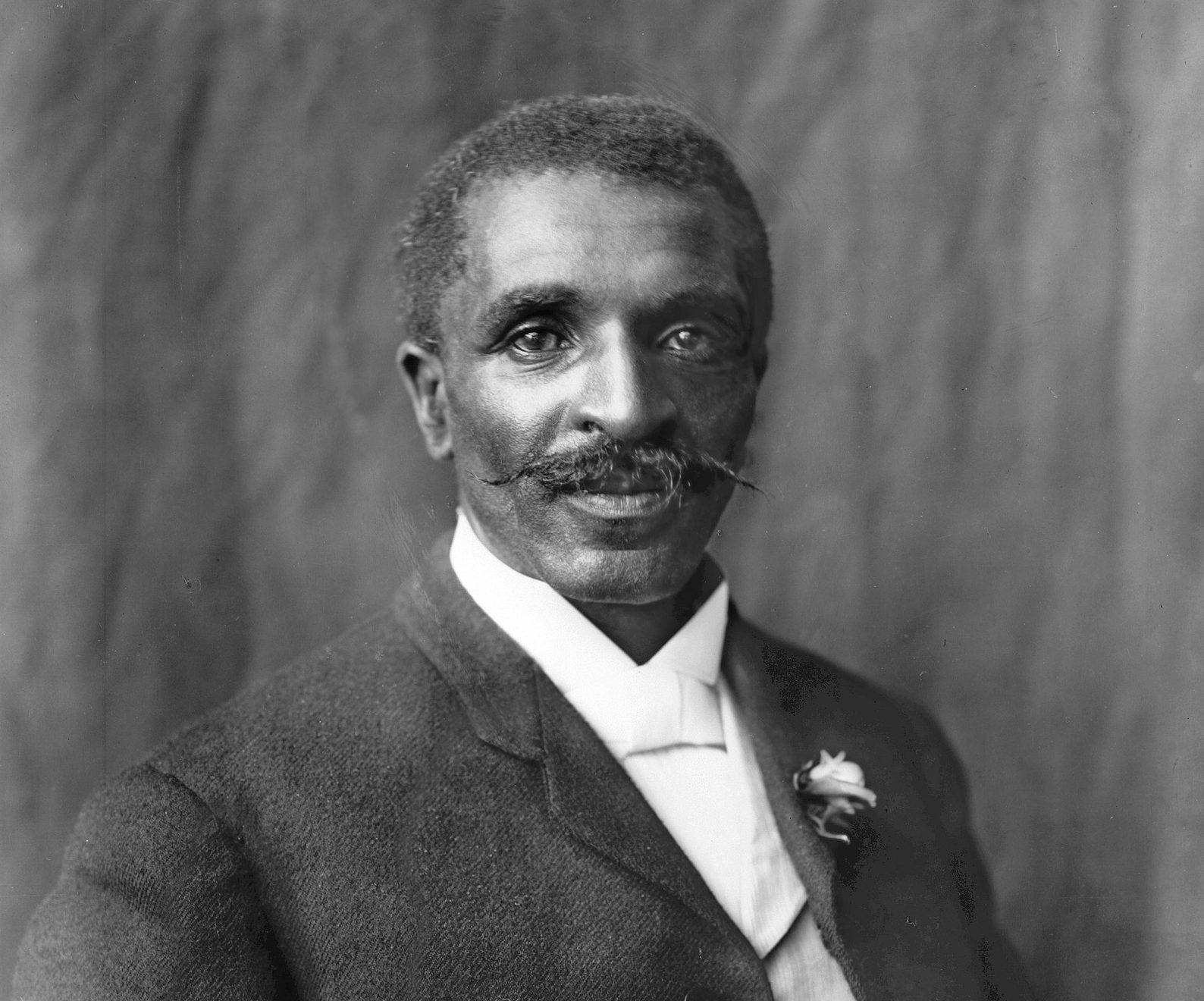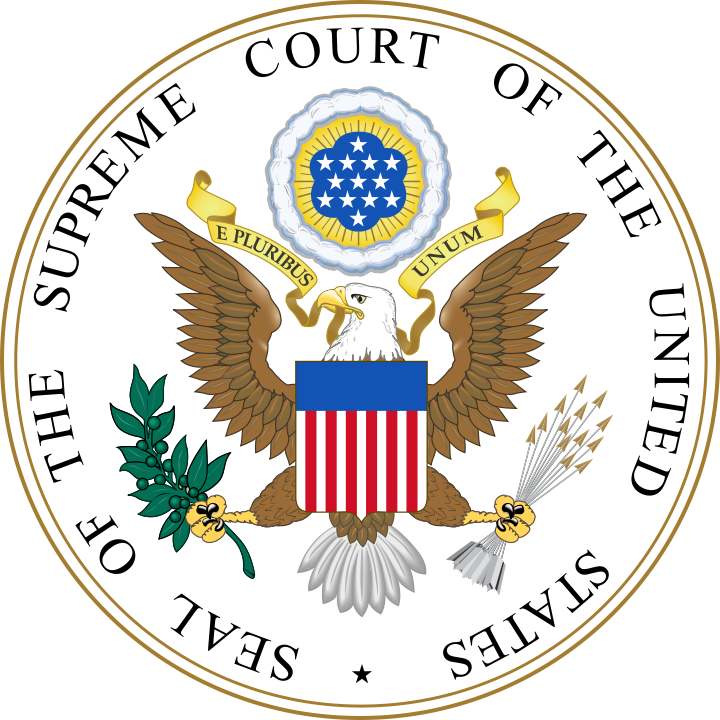Patent of the Day: Fishing Lure
Suiter Swantz IP takes a look back at past inventions and inventors with our Patent of the Day.
On this day in 1955, Madison A. Edson was granted U.S. Patent No. 2,711,048 for a FISHING LURE.
An excerpt from the patent states:
It is another object of this invention to provide an articulated fishing lure which is practically indestructible, and which is composed of relatively few parts capable of being formed of sheet metal by relatively simple stamping operations.
It is still another object of this invention to provide a fishing lure simulating a fish in general outline and having substantially flat tail and head sections hingedly coupled together in a manner to permit limited relative movement of the sections in practically all directions.
It is a further object of this invention to provide a fishing lure of the type set forth above having fins projecting laterally outwardly from opposite sides of the tail and head sections. These fins act somewhat similarly to sponsons or bearing areas and cooperate with the flat tail and head sections to impart the desired action to the lure during use.
It is still another object of this invention to provide the lure with bright contoured lines which impart attractiveness to the lure and make it readily visible when in use. The head, tail and fins of the lure may be formed of bright sheet metal such as aluminum and the bright contour lines may be produced on one or more of the above parts by an engraving operation. As a result of the engraving operation, shallow grooves or scratches are formed in the parts, and these grooves or scratches reflect the light to such an extent that the lure gives a bright flashing appearance when in use.
Suiter Swantz IP is a full-service intellectual property law firm, based in Omaha, NE, serving all of Nebraska, Iowa and South Dakota. If you have any intellectual property questions or need assistance with any patent, trademark or copyright matters and would like to speak to one of our patent attorneys please feel free to contact us.
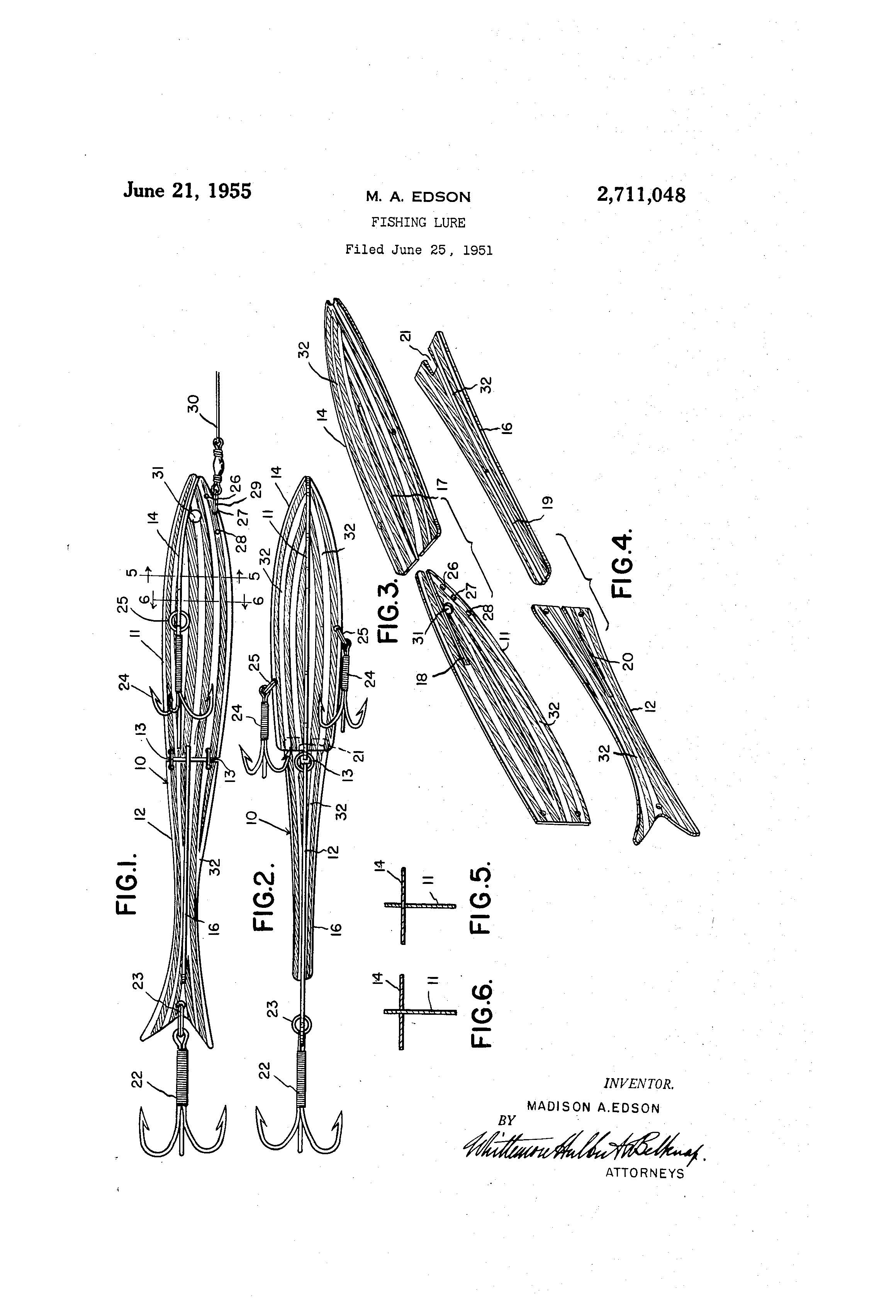
“Welcome to the Hotel California”?
The Eagles, a rock band known for their many award-winning songs and albums, have filed a trademark lawsuit in the U.S. District Court, Central District of California against a hotel in Mexico. The hotel, located in Todos Santos, Mexico, operates under the name Hotel California Baja LLC.
The 1976 hit “Hotel California” is one of the most popular and iconic songs associated with the band and they feel the hotel is trying to capitalize on the song and band’s fame.
The hotel first opened in 1950 as the Hotel California, but the name did not last long as the property underwent multiple changes in ownership. In 2001, Canadian couple Debbie and John Stewart purchased the hotel and restored it to its original name. The lawsuit alleges the couple did this intentionally as they “sought to revitalize the hotel and create a reputation for it, based at least partially on the hotel’s reputed, but false, connection to the Eagles.”
The lawsuit states “[t]hrough advertising targeted to U.S. consumers, and in person communications, defendants lead U.S. consumers to believe that the Todos Santos hotel is associated with the Eagles and, among other things, served as the inspiration for the lyrics in ‘Hotel California,’ which is false. Multiple online reviews make clear that U.S. consumers who visit the Todos Santos hotel and buy defendants’ merchandise do, in fact, believe that the Todos Santos hotel is associated with the Eagles, which is not the case.”
The hotel allegedly plays the famous song and other Eagles’ hits in the lobby and throughout the hotel. The hotel also sells merchandise such as key chains, bathrobes, t-shirts, sweatshirts, guitar pics that feature the Eagles name and cover art from the “Hotel California” album. The hotel reportedly also applied to register the Hotel California name with the United States Patent and Trademark Office (USPTO).
Although the hotel’s website states they have no affiliation with the famous rock band, continued reading suggests otherwise. It states, “Many … legends are less black and white and continue to fascinate the public. Although the present owners of the hotel do not have any affiliation with the Eagles, nor do they promote any association, many visitors are mesmerized by the ‘coincidences’ between the lyrics of the hit song and the physicality of the hotel and its surroundings.”
One of the coincidences the hotel mentions is the opening line to the famous song, “on a dark desert highway, cool wind in my hair.” The hotel refers to this by saying “Hotel California is accessed by driving down a long desert highway from either Los Cabos to the south or La Paz to the east.” In another verse of the song it says “I heard the mission bell” the hotel states “[t]he Mission Church of Pilar is located directly adjacent to the hotel and mission bells are heard daily.”
Despite the supposed coincidences between the song and the hotel, Don Henley, singer of the song and Eagles band member, said the song isn’t even about a hotel or California at all. “It’s a journey from innocence to experience. It’s not really about California; it’s about America. It’s about the dark underbelly of the American dream. It’s about excess, it’s about narcissism. It’s about the music business. … It can have a million interpretations.”
The Eagles are seeking an injunction to ban the hotel from further infringement by using the name Hotel California or anything that would imply it is connected to or approved by the band and are asking for all related profits plus actual and exemplary damages.
Suiter Swantz IP is a full-service intellectual property law firm based in Omaha, NE, serving all of Nebraska, Iowa, and South Dakota. If you have any intellectual property questions or need assistance with any patent, trademark, or copyright mattes and would like to speak to one of our patent attorneys please feel free to contact us.
Patent of the Day: Golf Club
Suiter Swantz IP takes a look back at past inventions and inventors with our Patent of the Day.
On this day in 1928, John Williams Quynn was granted U.S. Patent No. 271,866 for a GOLF CLUB. An excerpt from the patent states:
This invention aims to provide a novel form of golf club, the same embodying the features of a lofting club and straight face of a driving club, the object of the invention being to provide a club which will greatly increase distance when used in the rough or in a sand trap.
Another object of the invention is to provide a club which will not only pick up the ball but one wherein the follow through will cause the club to drive the ball forwardly.
With the foregoing and other objects in view which will appear as the description proceeds, the invention resides in the combination and arrangement of parts and in the details of construction hereinafter descrimed and claimed, it being understood that changes in the precise embodiment of the invention herein disclosed, may be made within the scope of what is claimed without departing from the spirit of the invention.
Suiter Swantz IP is a full-service intellectual property law firm, based in Omaha, NE, serving all of Nebraska, Iowa and South Dakota. If you have any intellectual property questions or need assistance with any patent, trademark or copyright matters and would like to speak to one of our patent attorneys please feel free to contact us.

Welcome New Hire Linda Dammann
We are excited to announce our team continues to grow. Please join us in welcoming Linda Dammann to the Suiter Swantz IP team!
Linda Dammann joined Suiter Swantz IP in 2017 as a paralegal for the Firm. Linda has over 25 years of experience in Intellectual Property, specializing in trademarks.
Linda’s expertise includes conducting availability searches, filing and monitoring trademarks with the United States Patent and Trademark Office and in several foreign countries.
Outside the office, Linda enjoys golf and spending time with her two grandchildren.
Welcome New Hire Sarah Williams
We are excited to announce our team continues to grow. Please join us in welcoming Sarah Williams to the Suiter Swantz IP team!
Sarah Williams joined Suiter Swantz IP in 2017 as an Intellectual Property Assistant. Sarah graduated from the University of Nebraska at Omaha with a Bachelor of Arts degree in Philosophy. She later received an Associate in Applied Science degree in Legal and Paralegal Studies from Metropolitan Community College, graduating with honors.
Outside of the office, Sarah enjoys live music, traveling, and Hawkeye football.
Patent of the Day: Apparatus for Utilizing the Force of the Waves of the Sea
Suiter Swantz IP takes a look back at past inventions and inventors with our Patent of the Day.
On this day in 1907, Peter Morice was granted U.S. Patent No. 890,994 for a APPARATUS FOR UTILIZING THE FORCE OF THE WAVES OF THE SEA.
This invention is adapted to be applied in any location where the undulating movements of the waves of the sea may be felt, therefore the apparatus may be installed either on a sea-grit rock, on the sea shore, or on board ship.
In giving effect to the invention, a platform is constructed in any suitable position, and from the platform is raised an overhead frame to support and give rigidity to the working parts. Below the platform are suspended a number of bottomless cylinders which contain easy fitting pistons or disks. The cylinders are adapted to rise and fall automatically as the tide rises and falls, but the pistons only rise and fall when acted upon by a wave. It is important that there should be a cushion of air between the underneath of the piston or disk and the water below. As the pistons or disks are raised or lowered by the wave force they will cause compression pumps to be operate to compress air which may be stored in any appropriate manner.
Suiter Swantz IP is a full-service intellectual property law firm serving all of Nebraska, Iowa and South Dakota. If you have any intellectual property questions or need assistance with any patent, trademark or copyright matters and would like to speak to one of our patent attorneys please feel free to contact us.

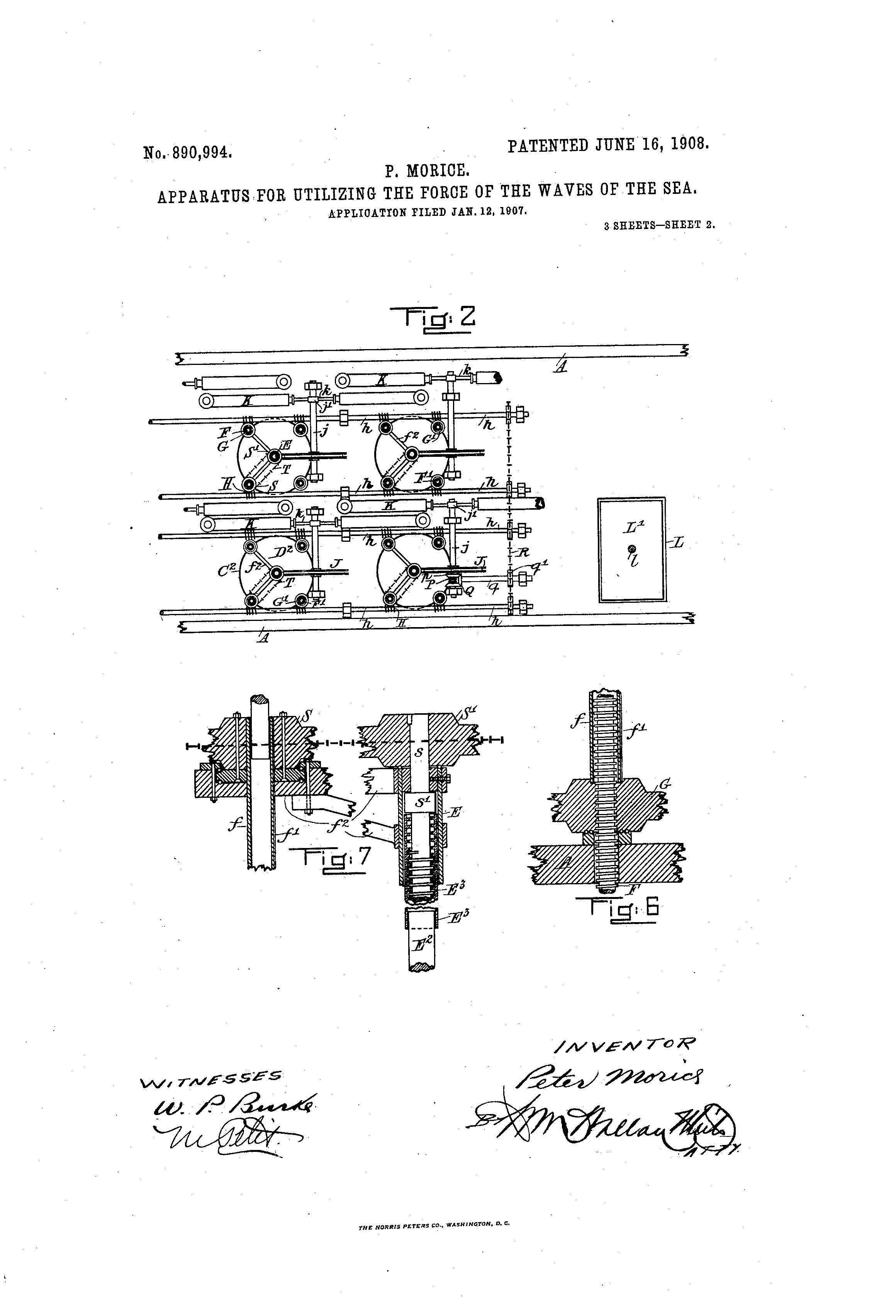
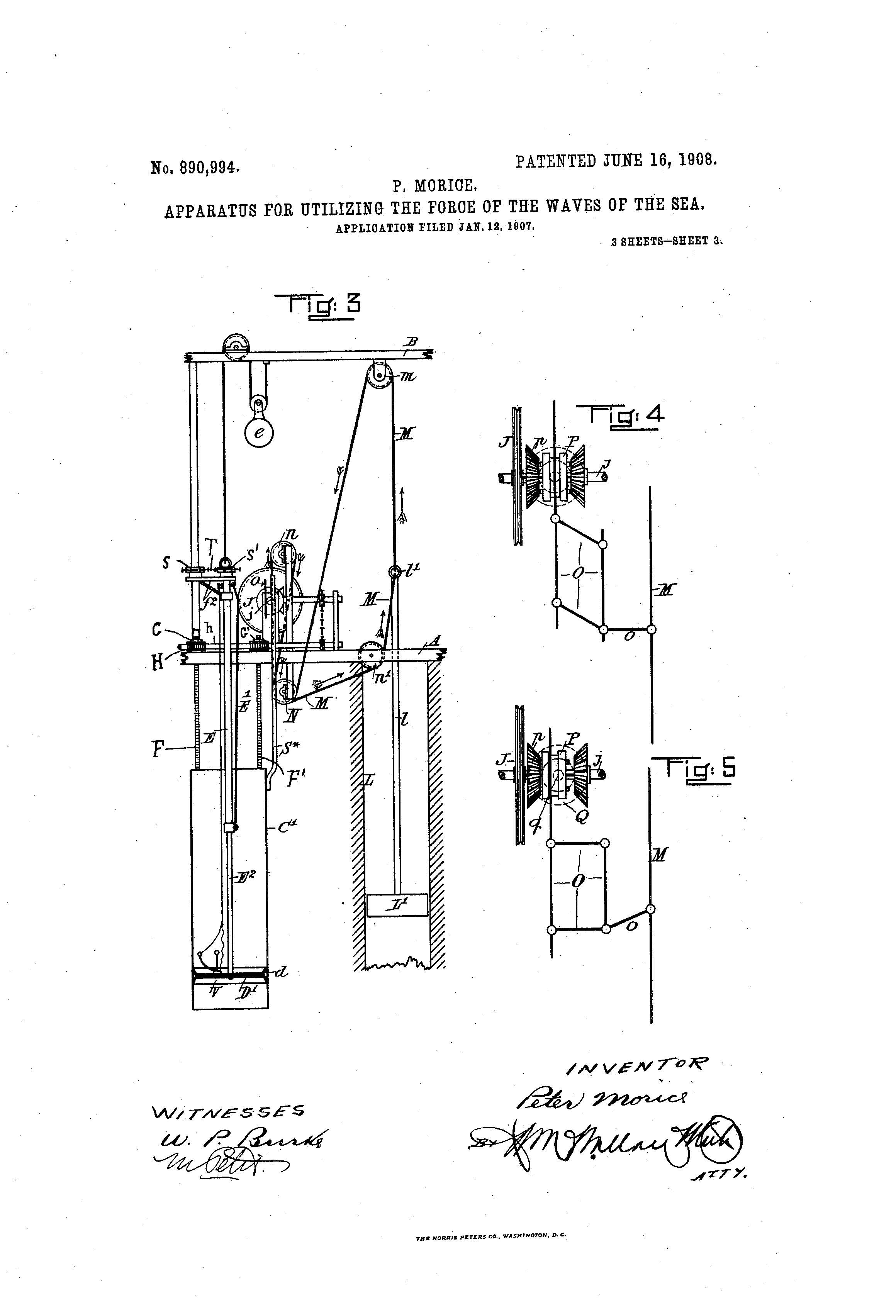
Nestle Loses Appeal to Trademark KitKat Bar's Shape
Candy bar maker Nestlé has recently lost an appeal to gain trademark protection for the shape of their famous KitKat bar. In many cases, a particular shape can illicit the thought of an associated product. For example, the Coca-Cola bottle and Toblerone chocolate bar both have distinct and recognizable shapes. As a result, both companies received trademarks for their unique shape. Nevertheless, it is rare for a three-dimensional object to be granted trademark status. Trademarks have the potential to remain registered indefinitely, which could potentially create a long-term monopoly on a possibly functional shape. In contrast, patents, which are designated for protecting functional products, have a limited term. To trademark a shape, the law requires that it be distinctive enough to allow consumers to distinguish it from other products apart from any logos or brand name listed on the packaging.
Nestlé is trying to protect the shape of their KitKat bar, which has what some would call a distinctive four-fingered shape, in the United Kingdom. The KitKat bar was first introduced to the public in 1935 by Rowntree and was called the Chocolate Crisp. The shape has changed little since its introduction and was acquired by Nestlé in 1998. A Norwegian candy bar called Kvikk Lunsj (meaning “quick launch”) has existed in the UK market since 1937 and has a look very similar to the KitKat bar.
The UK has been the arena for a long battle between the Swiss company Nestlé and the United States company Mondelēz, owners of Cadbury. In 2004, Cadbury attempted to trademark the shade of purple used in the packaging for their Dairy Milk Bars. Nestlé challenged the trademark and the application was rejected by the UK Court of Appeal in October 2013.
In the latest case between the two companies, Nestlé is on the losing end of a seven-year trademark battle. In the recent case Société des Produits Nestlé SA - and - Cadbury UK Ltd, the UK Court of Appeal ruled that the four-finger design had “no inherent distinctiveness”. The basic test applied by the requires that, to be distinctive, the three-dimensional trademark application must be for a shape that “departs significantly from the norms or customs of the industry.” (Chocoladefabriken Lindt & Sprüngli AG vs. OHIM) The three appeals judges deliberated for months before issuing a ruling that found the shape was not a “badge of origin”. Nestlé had appealed a lower UK court ruling that blocked the trademark registration and found that the shape was not distinctive enough to merit trademark protection and that such a designation would not comply with European law.
Appeal Court Justice Arnold stated that “it seems likely that customers rely only on the word KIT KAT and the other word and the pictorial marks used in relation to the goods in order to identify the trade origin of the product. The fact that Nestlé ensured that each finger was embossed with the Kit Kat logo amounted to a clear recognition that consumers did not rely upon the shape in that way, and that they in fact relied upon the trade mark Kit Kat.”
The court also cited Nestlé’s advertising efforts stating “the shape of the ‘KitKat’ bar has not been used to promote or market ‘KitKats’ in recent times. It has nothing, therefore, to do with informed choices that consumers make between similar products.”
Although this ruling makes the candy bar company vulnerable to copycats, it is unlikely the company will given up their quest any time soon. This is not the first time Nestlé has taken great efforts to gain trademark protection. The company spent more than 40 years trying to register the slogan “Have a Break” before finally giving up in 2006.
A Nestlé spokesperson suggested the company was not prepared to give up and were considering their next move. Nestlé has the option to take the case to the UK Supreme Court. The spokesperson also noted that “Nestlé’s four-finger shape has been granted trademark registration in many countries of the world, for instance Germany, France, Australia, South Africa and Canada, further protecting it from imitations.”
Suiter Swantz IP is a full-service intellectual property law firm, based in Omaha, NE, serving all of Nebraska, Iowa and South Dakota. If you have any intellectual property questions or need assistance with any patent, trademark or copyright matters and would like to speak to one of our patent attorneys please feel free to contact us.
Patent of the Day: Hockey Stick
Suiter Swantz IP takes a look back at past inventions and inventors with our Patent of the Day.
On this day in 1915, Newell T. Fogg was granted U.S. Patent No. 1,143,376 for a HOCKEY STICK.
This invention relates to a novel construction of a hockey stick such as is used by ice skaters. A stick of this general form is employed in playing the well known game of ice hockey. It is also common for one to carry such a stick when skating though not indulging in the game mentioned. Numerous accidents and fatalities constantly occur among the many devotees of this pastime in the higher latitudes through sudden breaking of the ice surface, or through the hidden dangers of air holes or rotted or weakened ice with the resultant precipitation of the skaters into the icy waters. Due to the fact that the ice surrounding such a break is usually cracked and weakened and of insufficient thickness and strength to hold others desirous of accomplishing rescue, it is common to attempt the extrication of the immersed skater by forming a chain of prostrate human bodies or by obtaining and throwing thereto a coil of rope, or by similar devices, which obviate the necessity for a person to approach unaided the hole or break. Such tactics entail delays which often prevent ultimate rescue, especially, where the ice is formed over running water and the immersed skater passes underneath the ice, or where he is unable to swim or keep afloat in the numbing water.
The object of this invention, therefore, is to provide a hockey stick, similar to those commonly carried by ice skaters, with a life saving means—a life line attachment. Another object is to construct such an improved hockey stick having a life line attachment which is carried on the stick in such manner as to form an improved handle or grip therefor.
Suiter Swantz IP is a full-service intellectual property law firm serving all of Nebraska, Iowa and South Dakota. If you have any intellectual property questions or need assistance with any patent, trademark or copyright matters and would like to speak to one of our patent attorneys please feel free to contact us.
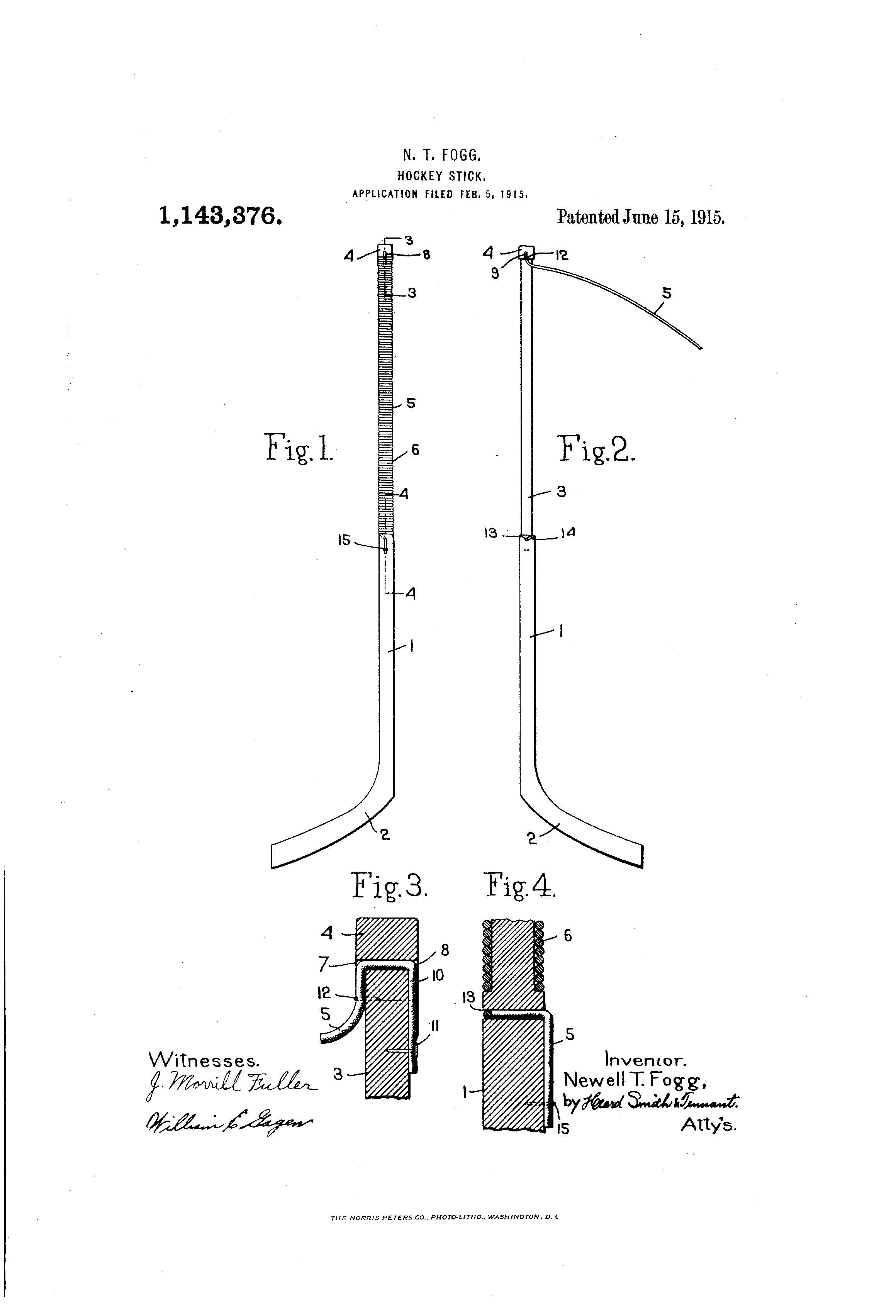
George Washington Carver granted patent for the Process of Producing Paints and Stains
On June 14 1927, George Washington Carver was granted U.S. Patent No. 1,632,365 for the "Process of Producing Paints and Stains."
In 1990, George Washington Carver was the first African American introduced into the National Inventors Hall of Fame. The induction was based not only on his work in botany, but also for two patents he was granted in 1925 and 1927. Carver only patented three of his inventions and when asked why, he said "if I did it would take so much time, I would get nothing else done. But mainly I don't want my discoveries to benefit specific favored persons."
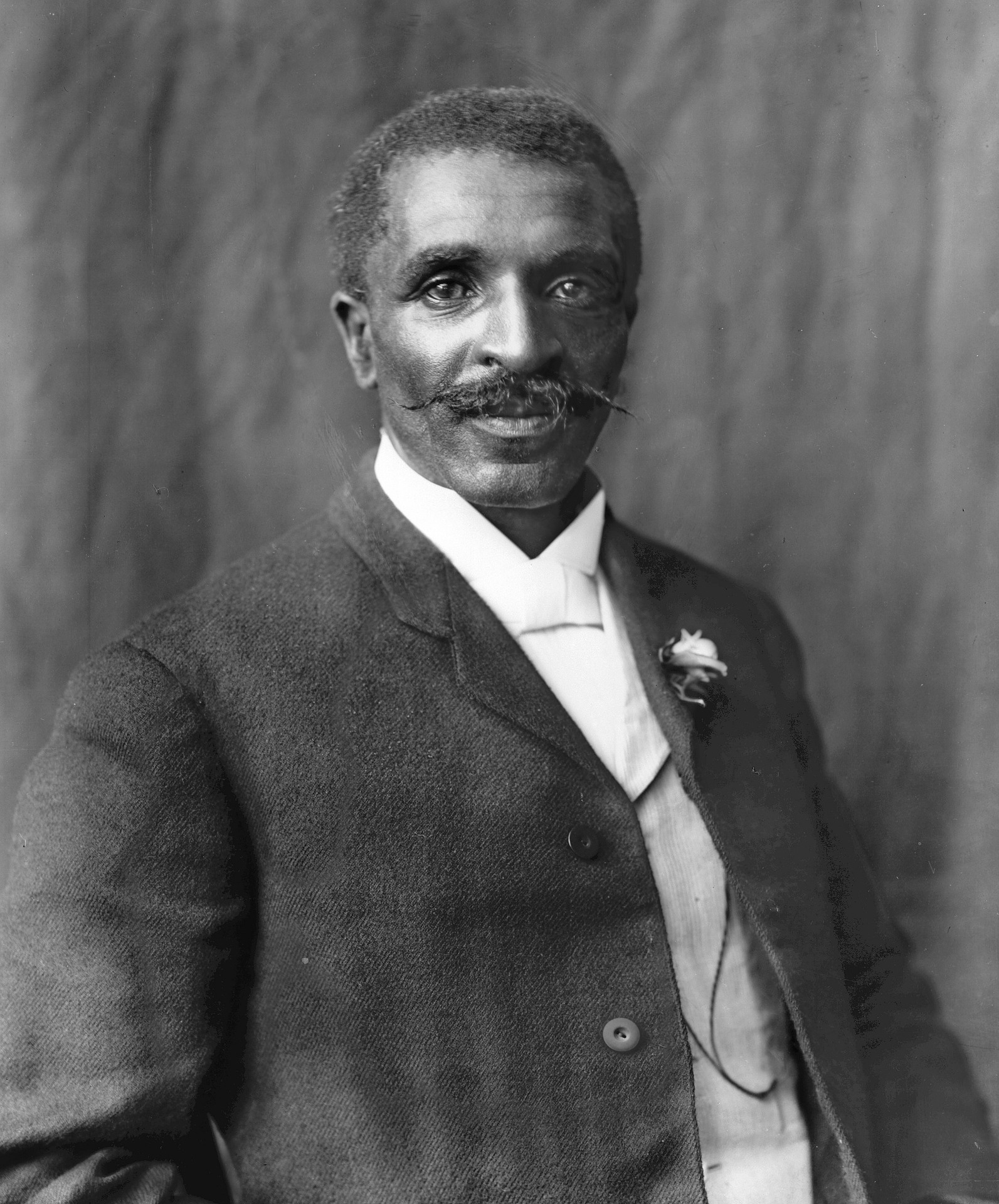
George Washington Carver was born into slavery in 1864. When he was an infant his family was kidnapped by Confederate raiders. The family was taken to Kentucky where they were separated and sold. Carver was sold to a family in Missouri that raised him and taught him to read. He began to experiment with plants, pesticides, soil conditions, etc. Carver became known as the "plant doctor" helping farmers improve their crops and fields.
It was not easy for Carver to get into a school. After much searching, he was able to attend the School for African American Children in Neosho, Kansas, which was a 10 mile walk from his home. Carver left home at 13 to continue his high school education and was eventually accepted into Highland Presbyterian College in Kansas. The school was very impressed with Carver throughout the admission process. However, on the first day of school, when they realized he was black they turned him away.
In 1888, Carver was accepted to Simpson College in Indianola, Iowa. His interest in botany led him to Iowa State Agriculture School where he earned his Bachelor of Science degree in 1894. The school was so impressed with his work they asked him to stay on as faculty while earning his Master’s Degree, which he obtained in 1896. He went on to be a faculty member at The Tuskegee Institute where he did research, taught students, and managed the schools farmland.
An excerpt from Carver's patent states:
"The invention relates to paints and stains, and has as an object the provision of a process for producing paints and stains from clays. Clays are found in many sections of the country of a variety of colors, and by a proper choice of color there may be produced by the process of the invention a large variety of colors of pigments, fillers and stains for treating wood or other materials.
To reduce the clay to a gelatinous condition the same is treated with acid. For this purpose taking as a basis a quantity of 25 pounds of clay free from sand or other objectionable substances, 25 pounds of commercial sulphuric acid and 25 pounds commercial hydrochloric acid may be added to the clay, with three pounds of clean scrap iron of any kind, iron turnings being a desirable form for the iron.
The clay and iron are put into an acid-proof vessel which is capable of withstanding heat, as for instance a porcelain vessel. The acids are added with enough water to make a thin paste. The substance is then boiled slowly, with frequent stirring, until the iron is dissolved and the whole mass assumes a uniform color. Water free from alkali is then added sufficient to substantially double the volume, when the solution is well stirred and allowed to settle for about five minutes, for the purpose of settlement of coarser portions.
The material remaining in suspension with the liquid is then decanted into shallow acid proof vessels and the remaining coarse and insoluble material is thrown away. The material thus secured is utilized as a base for subsequent steps, the nature of which, as well as the nature of the clay first taken for treatment may be chosen to vary the color of the resultant products."
---
Suiter Swantz IP is a full-service intellectual property law firm providing client-centric patent, trademark, and copyright services. If you need assistance with an intellectual property matter and would like to speak with one of our attorneys, please contact us at info@suiter.com.
Judge Orders Uber to Return Stolen Files to Waymo
On Monday May 15, U.S. District Court Judge William Alsup granted a partial injunction that ordered Uber Technologies Inc. to return stolen files to Waymo, the Alphabet subsidiary now handling Google’s self-driving car project.
On Thursday May 11, under a sealed order, Alsup referred the case to the U.S. Department of Justice to further investigate the claims of trade secret theft. Alsup felt there was enough evidence to initiate a criminal investigation of claims that Uber stole self-driving technology from Waymo.
We previously wrote about the lawsuit that Waymo filed against Uber in February that alleged Uber stole vital proprietary information about its self-driving technology. The focus of Waymo’s lawsuit centered around Otto, a self-driving truck startup, acquired by Uber in 2016 for $680 million. The founders of Otto are ex-employees of Google, one of which is Anthony Levandowski. Waymo alleged six weeks prior to his resignation, Levandowski “downloaded over 14,000 highly confidential and proprietary design files for Waymo’s various hardware systems, including designs of Waymo’s LiDAR and circuit board.” Waymo further alleged many of the employees who left Waymo for Otto also downloaded “Waymo trade secrets in the days and hours prior to their departure.”
In the court order Alsup wrote “[t]he bottom line is the evidence indicates that Uber hired Levandowski even though it knew or should have known that he possessed over 14,000 confidential Waymo files likely containing Waymo’s intellectual property; that at least some information from those files, if not the files themselves, has seeped into Uber’s own LiDAR development efforts; and that at least some of said information likely qualifies for trade secret protection.”
Waymo responded to the recent order and said "[c]ompetition should be fueled by innovation in the labs and on the roads, not through unlawful actions. We welcome the order to prohibit Uber’s use of stolen documents containing trade secrets developed by Waymo through years of research."
Alsup stated in the order that Levandowski is to be removed from any involvement in LiDAR work; he is to be removed from all communication and involvement with LiDAR, and he is prohibited from “consulting, copying, or otherwise using the downloaded materials in any way.” It should be noted that Uber had already taken these measures prior to the Judge’s ruling.
Alsup also ordered Uber to submit all communications, written and oral, in a chronological log where Levandowski discussed LiDAR with anyone. The log is to detail times, places, subjects involved and any notes that may have been taken. A “thorough investigation” is also to be performed for every Uber employee "who has seen or heard any part of the downloaded materials" and that information is to be submitted under oath. The log is to be turned into Waymo and the Court by June 23, 2017.
The above orders come with a strict adherence guideline in that complete and detailed records are to be taken to prove compliance with the judge’s orders. Uber was also ordered to turn over all downloaded materials by Levandowski to Waymo or the Court by May 31, 2017.
Levandowski has refused to testify in this case and has invoked his Fifth Amendment right against self-incrimination. Although this is a blow to Uber, the company did catch a small break when Alsup did not require Uber to halt their autonomous car research as Waymo had originally requested. Alsup did not feel as though the patent infringement claims brought by Waymo were strong enough to support an order and said “Waymo’s patent infringement accusations on this motion also proved meritless.”
In an emailed statement, an Uber spokesperson said "[w]e are pleased with the court's ruling that Uber can continue building and utilizing all of its self-driving technology, including our innovation around LiDAR. We look forward to moving toward trial and continuing to demonstrate that our technology has been built independently from the ground up."
In a recent update, a court filing made by Levandowski on May 18, 2017, alleges that Alsup is pressuring Uber to terminate Levandowski’s employment if he does not waive his fifth amendment right, cooperate, and answer questions. Levandowski confirmed Uber did in fact threaten to terminate his employment unless he waives his constitutional right against self-incrimination and reveals whether he took any Waymo documents. In a letter to Levandowski, Uber’s general counsel stated, “[w]hile we have respected your personal liberties, it is our view that the court’s order requires us to make these demands of you.”
Levandowski asked the court to modify the injunction to show the court order is not coercing Uber to terminate his employment and waive his fifth amendment right.
Unfortunately, for Anthony Levandowski, Uber has officially terminated his employment as of Tuesday May 30, 2017. Levandowski was asked by Uber to provide them with information but missed the internal deadline. In a statement to Uber employees, Uber’s associate general counsel for employment and litigation, Angela L. Padilla said, “[o]ver the last few months Uber has provided significant evidence to the court to demonstrate that our self-driving technology has been built independently. Over that same period, Uber has urged Anthony to fully cooperate in helping the court get to the facts and ultimately helping to prove our case.” Padilla further stated, “[w]e take our obligations under the court order very seriously, and so we have chosen to terminate his employment at Uber.”
Suiter Swantz IP is a full-service intellectual property law firm serving all of Nebraska, Iowa and South Dakota. If you have any intellectual property questions or need assistance with any patent, trademark or copyright matters and would like to speak to one of our patent attorneys please feel free to contact us.
Patent of the Day: Method and Means of Magnetic Recording
Suiter Swantz IP takes a look back at past inventions and inventors with our Patent of the Day.
On this day in 1944, Marvin Camras was granted U.S. Patent No. 2,351,004 for a METHOD AND MEANS OF MAGNETIC RECORDING.
This invention relates to a method and means of magnetic recording, and more particularly, to a system for linearly impressing magnetic variations or recordings on a completely demagnetized steel wire.
A system for magnetically recording audible sounds on a steel wire was developed in 1898 by Valdemar Poulsen. The Poulsen system, as well as other systems developed and experimented with for some years thereafter, included the fundamental concept that a demagnetized paramagnetic body, such as a steel wire or tape, should be passed through a magnetic field whose intensity varied as a function of the fluctuating sound waves to be recorded. These systems, due to the fact that the steel wire was initially demagnetized, operated over and around the lower bend near the zero axis of the characteristic residual magnetization curve of the wire. Because the system operated on a non-linear portion of the residual magnetization curve, faithful recording and reproduction of the sound waves was impossible.
A radical change in the underlying principle of magnetic recording and reproduction was made at a much later date by causing the steel wire or tape to be magnetically saturated and then passing it through an opposite weaker magnetic field modulated by the wave to be recorded. This basic type of system was a tremendous improvement over the earlier system, although the fundamental nature of the system still made it inherently impossible to obtain completely distortionless recording and reproduction. A body which is magnetically saturated without aging or other treatment, such as was necessary in the use of such wire or tape is very sensitive to extraneous demagnetizing effect. It is a well known fact that all permanent magnets immediately after magnetization lose some of their magnetism, and for that reason, most permanent magnets have to be aged. This made the above system very susceptible to noise due to mechanical handling, etc., of the wire or tape. A further cause for distortion occurring in this latter system is due to the fact that the system operates on a curved portion of the demagnetization curve, and although this curved portion is nearly straight, and nothing like the abrupt knee portion of the curve over which the earliest system operated, it nevertheless did cause some distortion to occur.
A modification of this system involved employing a modulated high frequency wave of the exciting current for producing a field to partially demagnetize the saturated record medium. This system retains the same characteristic features as those last discussed above.
An important feature and object of the present invention is to provide a system in which recording is made on a demagnetized paramagnetic body and in which the residual magnetization curve is linear where it passes through the zero position of the residual magnetization curve and continues to remain linear throughout the maximum range of operation.
Another object of the present invention is to provide a new method and means for magnetic recording on a paramagnetic body. A further object of the present invention is to provide a novel method and means for recording on a demagnetized paramagnetic body while operating on a substantially linear residual magnetization curve. A still further object of the present invention is to provide a novel method and means of magnetically recording on a magnetizable body which includes simultaneously impressing a high frequency alternating current and the wave to be recorded thereon.
Still another object of the present invention is to provide a novel method and means for straightening out the lower knee in the residual magnetization curve of the magnetizable body. Another and still further object of the present invention is to provide a novel recording and reproducing head in a system where voice or other sound waves are magnetically recorded on a steel wire and reproduced therefrom. Still another and further object of the present invention is to provide a novel magnetic recording system in which the recording head is energized by a high frequency alternating current connected in parallel with the fluctuating electric current produced by the sound to be recorded.
Suiter Swantz IP is a full-service intellectual property law firm serving all of Nebraska, Iowa and South Dakota. If you have any intellectual property questions or need assistance with any patent, trademark or copyright matters and would like to speak to one of our patent attorneys please feel free to contact us.
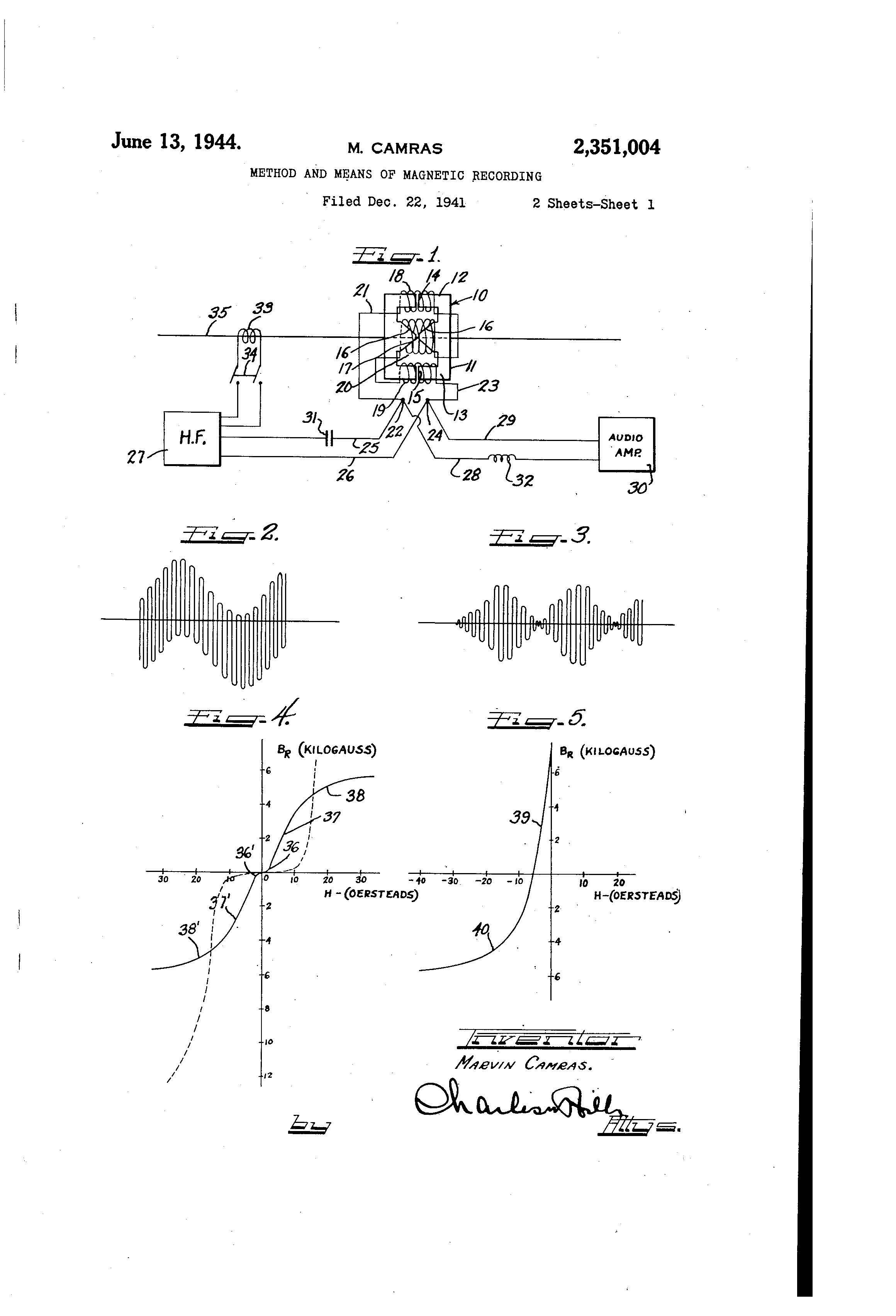
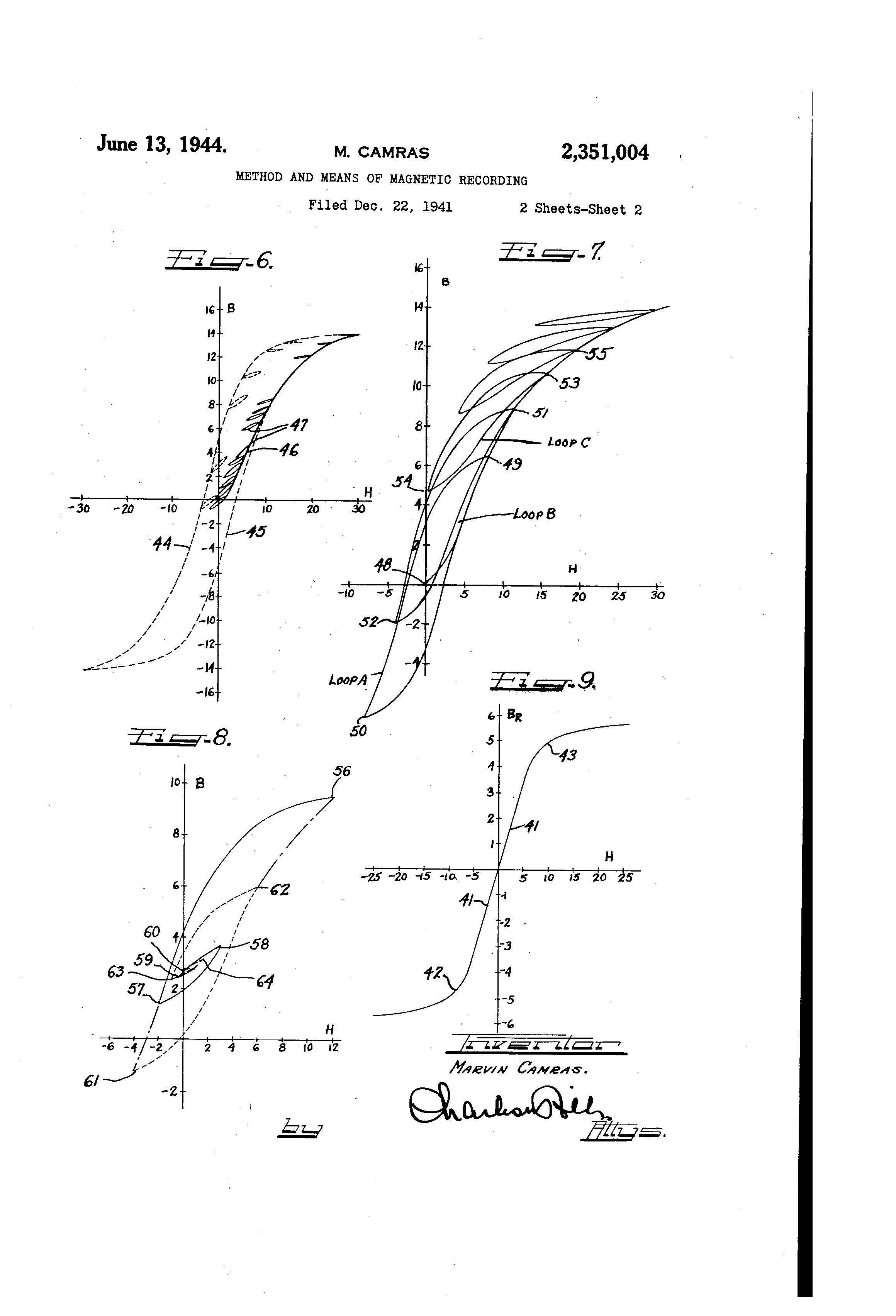
Supreme Court Limits Where Patent Infringement Lawsuits can be Filed
On Monday, May 22, 2017, the Supreme Court of the United States handed down a unanimous decision, delivered by Justice Clarence Thomas (minus Justice Gorsuch who took no part in the consideration) in the highly-anticipated case of TC Heartland LLC v. Kraft Food Group Brands LLC.
The question presented in this case relates to where the proper venue lies for a patent infringement lawsuit brought against a domestic corporation. TC Heartland, located and organized in Indiana, manufactures flavored drink mixes. Kraft Food Group, organized in Delaware, with its principal business located in Illinois, also manufactures flavored drink mixes. Kraft alleged TC Heartland infringed on three of their patents and sued the company for infringement in the district of Delaware. TC Heartland is not registered to conduct business in Delaware and does not have a significant presence in the area, but it does ship the allegedly infringing product to the State.
TC Heartland unsuccessfully petitioned the Court of Appeals for the Federal Circuit (CAFC) for a writ of mandamus to have venue of the case moved to Indiana and stated that Delaware was an improper venue. The CAFC’s interpretation of 28 U.S.C. § 1400(b) stated that the venue of the District of Delaware was in fact proper if that court was able to exercise personal jurisdiction over TC Heartland. The Supreme Court then granted certiorari.
The Supreme Court heard arguments for the case and reversed the CAFC’s decision subsequently ruling that patent venue statute 28 U.S.C. § 1400(b), which provides, “[a]ny civil action for patent infringement may be brought in the judicial district where the defendant resides, or where the defendant has committed acts of infringement and has a regular and established place of business.” For the purposes of § 1400(b), in light of Fourco Glass Co. v. Transmirra Products Corp., the Supreme Court’s interpretation concluded that a domestic corporation “resides” only in its State of incorporation. Justice Thomas stated, “[t]he current version of §1391 does not contain any indication that Congress intended to alter the meaning of §1400(b) as interpreted in Fourco.”
The Supreme Court further rejected an argument that there is a broader definition of “residence” in the patent venue statute § 1391(c), which Congress has amended twice and now states, “[e]xcept as otherwise provided by law” and “[f]or all venue purposes,” a corporation is found to be a resident “if a defendant, in any judicial district in which such defendant is subject to the court’s personal jurisdiction with respect to the civil action in question.” The amendments made to § 1391(c) did not modify the meaning of § 1400(b) and the Supreme Court held “that a domestic corporation ‘resides’ only in its State of incorporation for purposes of the patent venue statute.”
Ted Gelov, CEO of TC Heartland stated “[i]ndividuals and businesses in the U.S. have been unfairly required for decades to defend patent suits in far off locales adding cost, complexity and unpredictably to the intellectual property marketplace. The Supreme Court’s decision in favor of Heartland changes that system for the better.”
Kraft also commented on the ruling. Michael Mullen, SVP of corporate and government affairs of Kraft said, "[w]hile we are disappointed in the Supreme Court's ruling on this procedural matter, we respect the Court's opinion and do not believe it has any impact on the ultimate outcome of our case."
This Supreme Court ruling will put limits on where patent-infringement lawsuits can be filed, reducing the flexibility for patent owners in choosing a venue that they believe will be favorable to them. This case has a grabbed the attention of many patent owners, since a large portion of patent litigation cases, around 35%, are heard in the Eastern District of Texas, known as the “Rocket Docket.” Many believe that this court is more favorable to patent owners. This decision will no doubt impact the frequency with which the Rocket Docket is utilized by patent owners.
Suiter Swantz IP is a full-service intellectual property law firm serving all of Nebraska, Iowa and South Dakota. If you have any intellectual property questions or need assistance with any patent, trademark or copyright matters and would like to speak to one of our patent attorneys please feel free to contact us.


